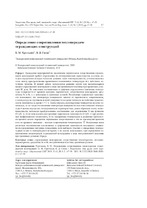| dc.contributor.author | Хрусталев, Б. М. | ru |
| dc.contributor.author | Сизов, В. Д. | ru |
| dc.coverage.spatial | Минск | ru |
| dc.date.accessioned | 2018-01-24T06:43:30Z | |
| dc.date.available | 2018-01-24T06:43:30Z | |
| dc.date.issued | 2018 | |
| dc.identifier.citation | Хрусталев, Б. М. Определение сопротивления теплопередаче ограждающих конструкций = Determining heat transmission resistance of enclosing structures / Б. М. Хрусталев, В. Д. Сизов // Энергетика. Известия высших учебных заведений и энергетических объединений СНГ. - 2018. - № 1. - С. 47-59. | ru |
| dc.identifier.uri | https://rep.bntu.by/handle/data/36809 | |
| dc.description.abstract | Проведение мероприятий по увеличению термического сопротивления ограждающих конструкций требует определения их теплофизических характеристик, в основу методов определения которых положено решение задач теплопроводности, устанавливающее связь между пространственно-временными изменениями температуры под действием источника теплоты. В данной работе используется решение задачи при нестационарном нагреве ограждающей конструкции в виде неограниченной пластины при граничных условиях III рода. По известным соотношениям и графикам определяются изменения температуры поверхности от времени прогрева, термического сопротивления конструкции, аргументов Fo и Bi, т. е. начальных и граничных условий. Полученные графические зависимости показывают, что температура поверхности зависит от термического сопротивления, а температура на противоположной поверхности за время теплового воздействия практически не изменяется за время τ = 5 ч. Таким образом, если наружная температура воздуха изменилась, то по скорости изменения температуры поверхности или относительной температуры θ можно определить теплофизические характеристики, решая обратную задачу теплопроводности, используя преобразованное соотношение для определения R как функцию R = ƒ(θ, τ). Если использовать построенные графические зависимости R = ƒ(θ, τ) при различных коэффициентах теплоотдачи, то по измеренным температурам в различные промежутки времени можно определить термическое сопротивление в эти же промежутки времени и по их среднему значению – искомое сопротивление теплопередаче R. Полученные нами расчетные аналитические соотношения и графические зависимости показывают адекватность проведенным натурным измерениям, если выбирать участки с однородным температурным полем и температурной историей, и их можно использовать при определении сопротивления теплопередаче ограждающей конструкции в виде неограниченной пластины при граничных условиях III рода. | ru |
| dc.language.iso | ru | ru |
| dc.publisher | БНТУ | ru |
| dc.title | Определение сопротивления теплопередаче ограждающих конструкций | ru |
| dc.title.alternative | Determining heat transmission resistance of enclosing structures | en |
| dc.type | Article | ru |
| dc.identifier.doi | 10.21122/1029-7448-2018-61-1-47-59 | |
| local.description.annotation | Fulfillment of the activities aimed to an increase of the thermal resistance of enclosing structures requires the determination of their thermophysical characteristics with the use of the determination method based on the solution of problems of heat conduction, establishing the con- nection between the spatial and temporal temperature changes under the effect of heat source. This work uses the solution of the problem under nonstationary heating of the enclosing structure in the form of unrestricted plate with boundary conditions of the III kind. According to the known relations and graphs alterations in surface temperature depending on warm-up time, on thermal resistance of constructions and on arguments of Fo and Bi, i. e. initial and boundary conditions are determined. The graphic dependencies that have been obtained show that the surface temperature depends on the thermal resistance, while the temperature at the opposite surface during heat exposure remains practically unchanged during τ = 5 h. Thus, if the outside air temperature is altered, then the rate of change of surface temperature or relative temperature θ make it possible to determine the thermophysical characteristics by solving the inverse problem of thermal conductivity with the use of the converted ratio to determine R as a function R = ƒ(θ, τ). If the constructed graphic dependencies R = ƒ(θ, τ) are used at different heat transfer coefficients, then according to the measured temperatures at different time intervals it is possible to determine thermal resistance in the same time intervals and, according to their average value, determine the required resistance to heat transfer R. The estimated ratio of analytical and graphic dependencies that we have obtained demonstrate the adequacy of the conducted full-scale measurements, if the areas with homogeneous temperature field and temperature history are chosen, and they can be used in determining the heat resistance of the enclosing structure in the form of unrestricted plate with boundary conditions of the III kind. | en |

